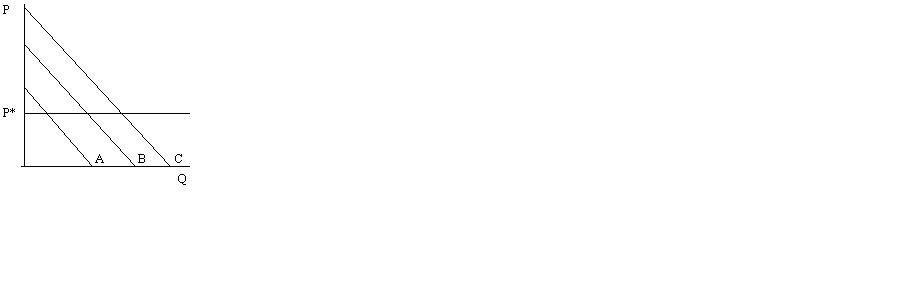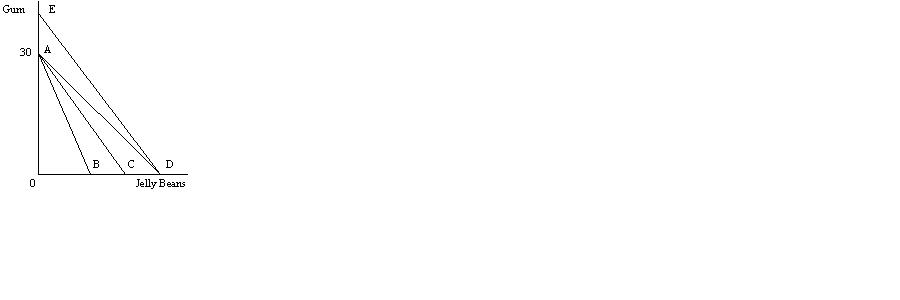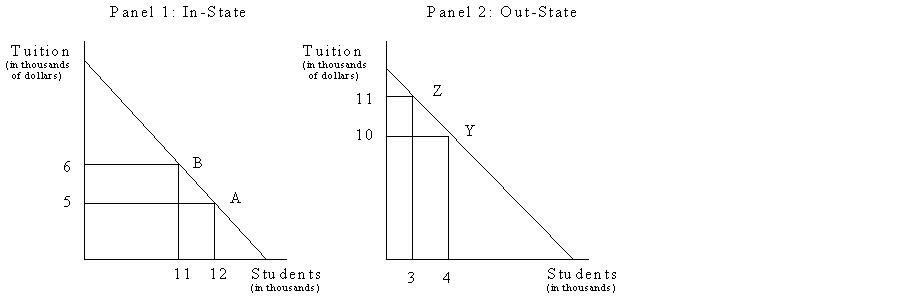
ECN 201, Spring 1997 NAME:__________________________ Prof. Bruce Blonigen SS#:__________________________ MIDTERM 1 - Version A Tuesday, April 22 **************************************************************************** Directions: This test is comprised of 2 parts for a total of 100 points. The first part is 30 multiple choice questions, with each question worth 2.5 points for a total of 75 points. The second part is short answer problems worth a total of 25 points. Mark your multiple choice answers on a Scantron with a #2 pencil. Put your name and student ID number on both the Scantron and this test. Then hand in both the Scantron and the test when you are finished. PART 1: MULTIPLE CHOICE 1) If the government imposes a price ceiling that is above the equilibrium price,a) this price ceiling will have no economic impact.
b) quantity demanded will be less than quantity supplied. c) demand will be greater than supply. d) the available supply will have to be rationed with a nonprice rationing mechanism. 2) People scalping tickets for a rock concert will be successful a) any time the rock group is popular.b) when the price set by the concert hall is less than the market equilibrium price.
c) when prices are too high. d) only when there is excess supply. 3) Price and total revenue are inversely related when demand isa) elastic.
b) inelastic. c) unitarily elastic. d) perfectly inelastic. 4) A change in the price of a good or service leads to a ________ which leads to a _______. a) change in demand; movement along the demand curveb) change in quantity demanded; movement along the demand curve
c) change in demand; shift in the demand curve d) change in quantity demanded; shift in the demand curve 5) A change in which of the following will not alter the demand curve for rental housing?a) rental housing prices.
b) wood prices.
c) population of the economy. d) a rise in home prices. 6) Which of the following is not illustrated by a production possibilities frontier? a) scarcity. b) opportunity cost. c) necessity for choice.d) prices.
7) Which of the following statements is most consistent with the efficient markets hypothesis? a) "It is not difficult to make money because profitable opportunities abound." b) "Hot tips from your stock broker should be acted on because the profit opportunities will be very long lasting."c) "Profit opportunities are rare because there are many people searching for such opportunities."
d) "The bond market, but not the stock market, is very likely to be a source of profit opportunities." 8) A retired individual decides to spend the day golfing. The opportunity cost of this decision a) is zero, since the individual is retired and is not forgoing any income to spend the day golfing. b) is equal to cost of the golf outing.c) equals the cost of the golf outing plus the value of the individual's alternative use of time.
d) is best measured by using the wage rate this individual earned prior to retirement. 9) A light rail system connecting two cities was originally thought to cost $20 million. After building part of the system at a cost of $15 million, the government realized that the total cost of the system would be $26 million, not $20 million. At this point, the MARGINAL cost of completing the light rail system is best estimated as a) $5 million. b) $6 million.c) $11 million.
d) $26 million. 10) The Setrite Corporation produces chairs. An economist working for the firm predicts that "if people's incomes rise next year, then the demand for our chairs will increase, ceteris paribus." The accuracy of the economist's prediction depends on whether the chairs Setrite produces a) have many complementary goods. b) have few substitutes. c) have few complementary goods.d) are normal goods.

11) Rank the demand curves A,B, and C (pictured to above) in order of greatest to least elasticity at P*.a) A, B, C.
b) C, B, A. c) B, C, A. d) indeterminate from information given. 12) Suppose commodities A and B are substitutes for one another in consumption and that the price of B rises. Which of the following will occur?a) Both the equilibrium price and quantity demanded of A will tend to rise.
b) Both the equilibrium price and quantity demanded of A will tend to fall. c) The equilibrium price of A will fall, while the equilibrium quantity demanded will rise. d) The equilibrium price of A will rise, while the equilibrium quantity demanded will fall. 13) One of the following will not cause the supply curve to shift a) The rise in the price of inputs. b) An increase in the number of suppliers.c) An increase in demand.
d) A change in technology. 14) If there is a large increase in the quantity of potatoes exchanged, but little or no change in price, the most likely explanation is that: a) supply has increased and demand has decreased.b) both supply and demand have increased.
c) only supply has increased. d) supply has decreased and demand has increased. 15) Which of the following statements would you expect to be true about cheese and food? a) Compared with food, cheese has a lower price elasticity of demand because it is specifically defined.b) Food has a lower price elasticity of demand because it is widely defined.
c) Because cheese is food, cheese and food have the same price elasticity of demand. d) The supply of cheese depends on people's purchases of food. 16) Which of the following is not likely to result if rent control is imposed in Eugene at a price ceiling below the equilibrium price ? a) excess demand for rental units. b) poor maintenance in existing rental units.c) an increase in construction of new rental units in response to the excess demand.
d) increased rental prices in Springfield where there is no rent control. 17) A shift in consumer preferences from pork to chicken may be predicted to cause a) a shift in the supply of chicken products. b) a fall in the equilibrium price of chicken products. c) a rise in the price of pork products.d) none of the above.
18) Which of the following is a positive statement? a) Unemployment is not so important a problem as inflation.b) None of the heroin consumption in the United States is by inner-city blacks.
c) Unemployment and inflation are equally important problems. d) None of the above are positive statements. 19) The price of good X is $1.50 and the price of good Y is $1.00. If a consumer has experienced a marginal utility of 30 units with the last consumption of good Y, then what must be the marginal utility of the consumer's last consumption of X if the consumer is optimizing correctly across these goods? a) 30 units. b) 15 units.c) 45 units.
d) none of the above.
 20) Refer to figure 1. If the consumer's initial budget
constraint is AC, what is their budget constraint after
the price of Jelly Beans declines?
a) AB
b) AD
20) Refer to figure 1. If the consumer's initial budget
constraint is AC, what is their budget constraint after
the price of Jelly Beans declines?
a) AB
b) ADc) AC d) None of the above 21) Refer to figure 1. Which of the following could lead to a consumer's budget constraint to shift from AC to ED? a) A decline in income. b) An increase in supply of Gum.c) A decline in both the price of Gum and Jelly Beans
d) A decline in the price of Gum and an increase in the price of Jelly Beans. 22) Refer to figure 1. If the consumer's budget constraint is AC and the price of Gum is $0.25, what is the income of the consumer?a) $7.50
b) $30.00 c) $120.00 d) Indeterminate from the information given. 23) Refer to figure 1. If the consumer's budget constraint is AC and the consumer has an income of $60, what is the price of Jelly Beans? a) $3.00 b) $2.00 c) $0.50d) Indeterminate from the information given.
24) Refer to figure 1. If the consumer's initial budget constraint is AD, what is their budget constraint after the price of Gum declines? a) ABb) ED
c) AC d) None of the above 25) Marge Simpson is buying shirts and shoes such that the marginal utility of shirts is 12 and the marginal utility of shoes is 3. Shirts and shoes are priced at $8 and $2 respectively. It can be concluded that Marge is a) spending too much on shirts and not enough on shoes. b) spending too much on shoes and not enough on shirts.c) spending her income on shirts and shoes in such a way as to maximize her satisfaction.
d) indeterminate from the information given. 26) If I discover that MUPIZZA / PPIZZA > MUBEER / PBEER , this implies that a) switching some funds from pizza to beer will increase my utility.b) switching some funds from beer to pizza will increase my utility.
c) pizza is more expensive than beer. d) I have maximized my utility if I prefer pizza to beer. 27) The demand for good A has been increasing the past year. You would conclude that good A is an inferior good which of the following is true? a) Good B, a substitute for good A, has cut its price over the last year. b) Good B, a complement to good A, has cut its price over the last year.c) An economic slowdown has reduced income of consumers in the economy.
d) Household wealth has increased. SITUATION 1: Suppose that the equilibrium wage for high school students in Oregon is $4, but the state passes a law that the minimum wage must be $5.50. 28) Situation 1 is an example of a) a price ceiling.b) a price floor.
c) the law of demand. d) increasing opportunity costs. 29) Which of the following would be a likely consequence of situation 1? a) Less high school students applying for jobs. b) Excess demand for high school workers.c) Less jobs for high school students at the new minimum wage of $5.50.
d) Fast food restaurants will hire more managers. 30) Refer to situation 1. Suppose instead that the state sets the minimum wage at $3.50, when the equilibrium wage is $4. Which of the following will likely occur? a) Excess demand for high school student workers. b) Excess supply of high school student workers. c) Worse maintenance at fast food restaurants.d) None of the above.
PART 2: SHORT-ANSWER PROBLEM
Because of Measure 47, the University of Oregon needs to increase total
revenue. The president of the University of Oregon suggests that raising
tuition by a $1000 for both in-state and out-state students will raise
total revenue. You estimate the demand for a UO education as depicted by
the following graphs. Panel 1 shows demand by in-state students and panel
2 shows demand for out-state students. Point A in panel 1 shows the
tuition and enrollment before the $1000 increase, and point B in panel 1
shows the tuition and enrollment after the increase. Point Y on panel 2
shows the tuition and enrollment for out-state students before the $1000
increase, and point Z shows the values of these variables afterward.
 Calculate the price elasticity of demand for in-state students over the
range from point A to B. Is demand elastic, unit elastic, or inelastic?
Show your work to get full credit and use the midpoint formula to
calculate the elasticity.
Price elasticity of demand over range A to B
Calculate the price elasticity of demand for in-state students over the
range from point A to B. Is demand elastic, unit elastic, or inelastic?
Show your work to get full credit and use the midpoint formula to
calculate the elasticity.
Price elasticity of demand over range A to B
Absolute value is less than one, so demand is INELASTIC over this range.
Calculate the price elasticity of demand for out-state students over the range from point Y to Z. Is demand elastic, unit elastic, or inelastic? Show your work to get full credit and use the midpoint formula to calculate the elasticity.Price elasticity of demand over range Y to Z
Absolute value is greater than one, so demand is ELASTIC over this range.
Calculate the total revenue change (in dollars) we can expect from the $1000 increase on in-state students. How does this relate to the price elasticity of demand for these students? (Hint: remember that total revenue = price*quantity) Show your work to get full credit.TR = P*Q
Therefore the change in total revenue is +$6 million. Total revenue goes up when we raise tuition on in-state students which makes sense because we calculated that the demand by in-state students is inelastic over this range of the tuition (i.e., the price) increase.
Calculate the total revenue change (in dollars) we can expect from the $1000 increase on out-state students. How does this relate to the price elasticity of demand for these students? Show your work to get full credit.TR = P*Q
Therefore the change in total revenue is -$7 million. Total revenue goes down when we raise tuition on out-state students which makes sense because we calculated that the demand by out-state students is elastic over this range of the tuition (i.e., the price) increase.
What's your recommendation to the president, given the demand functions in panel 1 and 2 above and your calculations?We should raise tuition on in-state students, but not on out-state students if our goal is to raise tuition revenue. In fact, we may be able to raise revenues by lowering tuition on out-state students if their demand is elastic over the range of a tuition decrease (we would have to calculate this).